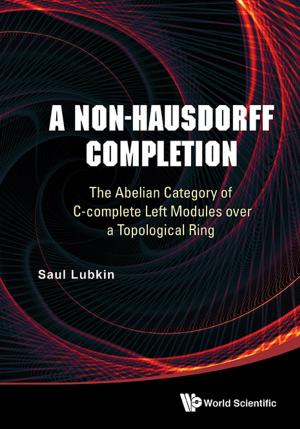Consciousness and Robot Sentience
Nonfiction, Science & Nature, Technology, Robotics, Computers, Advanced Computing, Artificial Intelligence| Author: | Pentti O Haikonen | ISBN: | 9789811205064 |
| Publisher: | World Scientific Publishing Company | Publication: | May 23, 2019 |
| Imprint: | WSPC | Language: | English |
| Author: | Pentti O Haikonen |
| ISBN: | 9789811205064 |
| Publisher: | World Scientific Publishing Company |
| Publication: | May 23, 2019 |
| Imprint: | WSPC |
| Language: | English |
THIS BOOK is the fully revised and updated second edition of 'Consciousness and Robot Sentience'. With lots of new material, it will provide new insights into artificial intelligence (AI) and machine consciousness, beyond materials published in the first edition. The organization of this book has been streamlined for better clarity and continuity of the lines of arguments.
The perspective of AI has been added to this edition. It is shown that contemporary AI has a hidden problem, which prevents it from becoming a true intelligent agent. A self-evident solution to this problem is given in this book.
This solution is surprisingly connected with the concepts of qualia, the mind-body problem and consciousness. These are the hard problems of consciousness that so far have been without viable solution. Unfortunately, the solution to the hidden problem of AI cannot be satisfactorily implemented, unless the phenomena of qualia and consciousness are first understood. In this book an explanation of consciousness is presented, one that rejects material and immaterial substances, dualism, panpsychism, emergence and metaphysics. What remains is obvious. This explanation excludes consciousness in digital computers, but allows the artificial creation of consciousness in one natural-like way, by associative non-computational neural networks.
The proof of a theory calls for empirical verification. In this case, the proof could be in the form of a sentient robot. This book describes a step towards this in the form of the author's small experimental robot XCR-1. This robot has evolved through the years, and has now new cognitive abilities, which are described.
Contents:
- Dedication
- Preface
- Artificial Intelligence
- Sensory Information and Meaning
- Self-Explanatory Information and Qualia
- Hypotheses about Consciousness
- The Explanation of Consciousness
- The Gateway to Mind; Sensory Perception
- Memory, Learning, Thinking and Imagination
- Natural Language and Inner Speech
- Emotions and Motivation
- Artificial Neural Networks
- Thinking and Associative Neural Networks
- Towards Artificial Cognitive Perception
- Examples of Perception/Response Feedback Loops
- Symbols in Perception/Response Feedback Loops
- Information Integration with Multiple Modules
- Emotional Significance in Associative Processing
- The Haikonen Cognitive Architecture (HCA)
- Mind Reading with HCA
- A Comparison of Some Cognitive Architectures
- Testing Artificial Consciousness
- An Experimental Robot with the HCA
- Appendix
- Some Experimental Neural Circuits
- Bibliography
- Index
Readership: This book demystifies both the enigmatic philosophical issues of consciousness and the practical engineering issues of conscious robots by presenting them in an easy-to-understand manner for the benefit of students, researchers, philosophers and engineers in the field.
Key Features:
- The proof of a theory calls for empirical verification. In this case, the proof could be in the form of a sentient robot
- This book describes a step towards this in the form of the author's small experimental robot XCR-1
- This robot has evolved through the years, and has now new cognitive abilities, which are described
THIS BOOK is the fully revised and updated second edition of 'Consciousness and Robot Sentience'. With lots of new material, it will provide new insights into artificial intelligence (AI) and machine consciousness, beyond materials published in the first edition. The organization of this book has been streamlined for better clarity and continuity of the lines of arguments.
The perspective of AI has been added to this edition. It is shown that contemporary AI has a hidden problem, which prevents it from becoming a true intelligent agent. A self-evident solution to this problem is given in this book.
This solution is surprisingly connected with the concepts of qualia, the mind-body problem and consciousness. These are the hard problems of consciousness that so far have been without viable solution. Unfortunately, the solution to the hidden problem of AI cannot be satisfactorily implemented, unless the phenomena of qualia and consciousness are first understood. In this book an explanation of consciousness is presented, one that rejects material and immaterial substances, dualism, panpsychism, emergence and metaphysics. What remains is obvious. This explanation excludes consciousness in digital computers, but allows the artificial creation of consciousness in one natural-like way, by associative non-computational neural networks.
The proof of a theory calls for empirical verification. In this case, the proof could be in the form of a sentient robot. This book describes a step towards this in the form of the author's small experimental robot XCR-1. This robot has evolved through the years, and has now new cognitive abilities, which are described.
Contents:
- Dedication
- Preface
- Artificial Intelligence
- Sensory Information and Meaning
- Self-Explanatory Information and Qualia
- Hypotheses about Consciousness
- The Explanation of Consciousness
- The Gateway to Mind; Sensory Perception
- Memory, Learning, Thinking and Imagination
- Natural Language and Inner Speech
- Emotions and Motivation
- Artificial Neural Networks
- Thinking and Associative Neural Networks
- Towards Artificial Cognitive Perception
- Examples of Perception/Response Feedback Loops
- Symbols in Perception/Response Feedback Loops
- Information Integration with Multiple Modules
- Emotional Significance in Associative Processing
- The Haikonen Cognitive Architecture (HCA)
- Mind Reading with HCA
- A Comparison of Some Cognitive Architectures
- Testing Artificial Consciousness
- An Experimental Robot with the HCA
- Appendix
- Some Experimental Neural Circuits
- Bibliography
- Index
Readership: This book demystifies both the enigmatic philosophical issues of consciousness and the practical engineering issues of conscious robots by presenting them in an easy-to-understand manner for the benefit of students, researchers, philosophers and engineers in the field.
Key Features:
- The proof of a theory calls for empirical verification. In this case, the proof could be in the form of a sentient robot
- This book describes a step towards this in the form of the author's small experimental robot XCR-1
- This robot has evolved through the years, and has now new cognitive abilities, which are described















